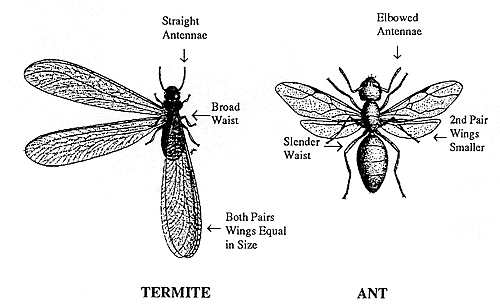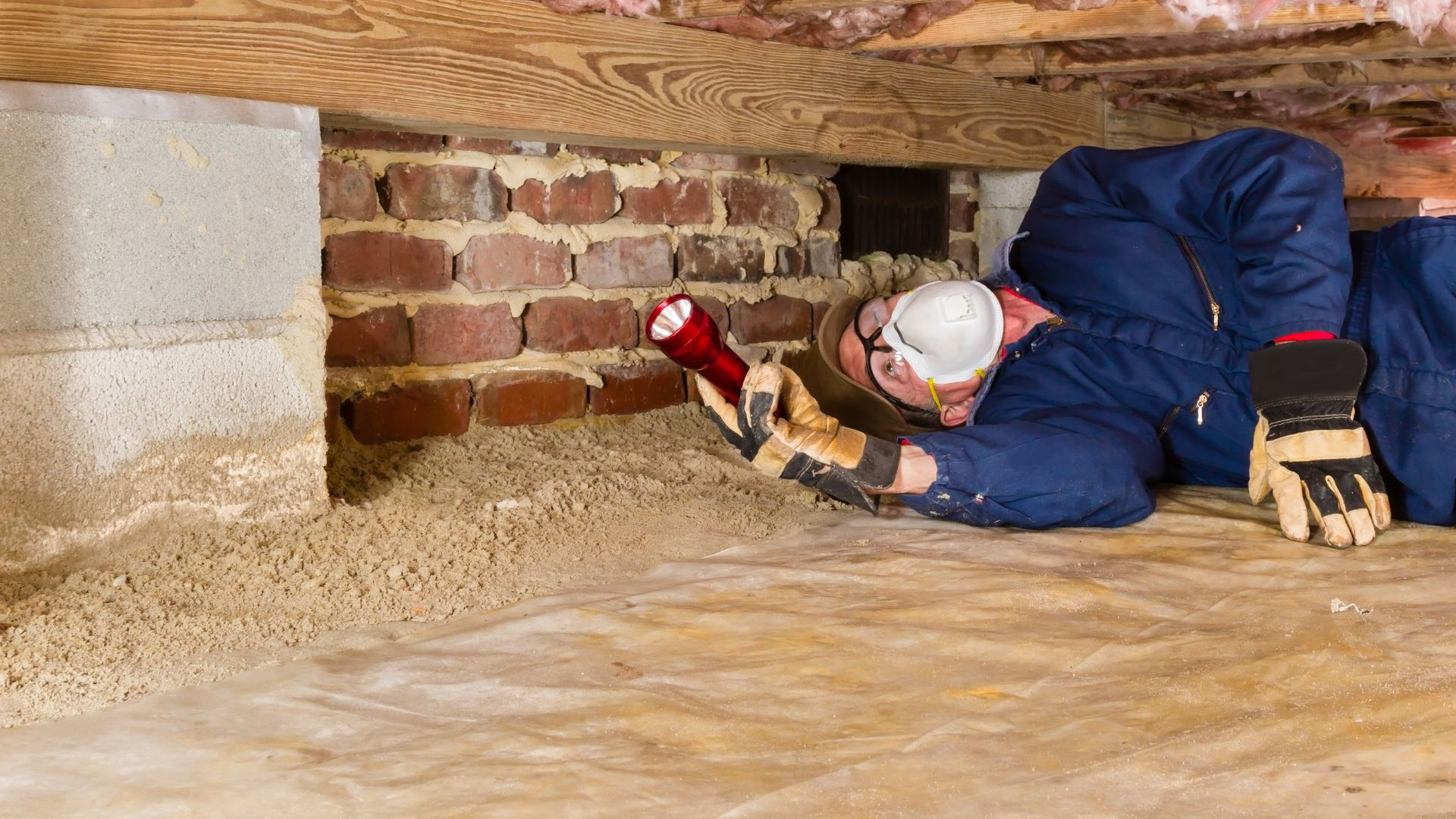
Flying Ants vs Termites With Wings
May 3rd, 2024
Termites, Flying Ants, or Other Insects?

Swarming insects are a common nuisance for property owners. However, contrary to popular belief, not all swarming insects are termites. Some are flying ants with wings. Pest control companies use physical differences to help them determine between ants with wings and termites.
Although flying ants and termites differ in many ways, it might be difficult to tell them apart at first look. Some flying winged ants resemble the winged-swarming termite.
Therefore, it's very important to understand the main physical differences between the two pests to treat the issue properly.
Difference Between Flying Ants and Termites
How to Identify Flying Ants
These flying insects have a pinched waist and bent antennae. Flying ants have two sets of brown wings, each of which is different in size, with the front wings longer and the hind wings smaller. The unequal length of the ant’s wings is a defining trait to look out for. Flying ants have black, brown, or reddish bodies.
Flying ants eat nectar, seeds, and other insects. They are commonly seen in and around food debris. Ants with wings undergo several development stages, including egg, larva, pupa, and adult. Worker ants have a short lifespan of 6-8 weeks, while the ant queen can live for years.
How to Identify Termites with Wings
Termites with wings have a vertical waist and straight antennae. Termites also have two sets of equal-length wings. Their bodies are black or dark brown and have a wider shape than flying ants.
Cellulose is the main dietary requirement for termites. This is why you will see swarms of termites flocking to nutrient-rich vegetation and plants, as well as wood and paper.
Termites have no pupae stage in development and instead cycle through egg, nymph (larvae), and adult phases. Termites tend to live a little longer than flying ants: most live for a few years, while the queen may survive several decades.

Top Tips to Identify Winged Ants vs Termites
-
While flying ants and termite swarmers have four wings, termite wings are uniform in size. Winged ants have noticeably larger wings in the front than the pair in the back. Termite's antennae are almost straight where the ant's antennae "elbows".
-
Termite wings are double the length of their body. Ant wings are noticeably shorter and much more proportionate to the length of their bodies.
-
Ants have a distinctly segmented appearance, because of their extremely narrow "pinched waists." For the most part, termites have a wide waist and feature a uniform width along their whole body.

Key Takeaway
Ants have a "pinched" waist.
Termite's wings are twice as long as the termite's body.
Ants have distinctly elbowed antennae.
How to Get Rid of Flying Ants vs Winged Termites
Once you have correctly identified the insect and completed a thorough inspection of your property, the next step is getting rid of the pests. Even in minor ant or termite infestations, if left untreated they can result in far bigger problems and lead to structural damage.
To get rid of a termite infestation, create a barrier around the perimeter surrounding your property. You can use diatomaceous earth or spray insecticide on the ground where flying ants or winged termites may fall.
You should also clean up any spills or food crumbs. Flying ants and winged termites are attracted to such sources, so it’s a good idea to keep areas clean and tidy.
Once these flying pests have been removed from your house, you should cover any gaps or cracks to prevent new ones from entering and continuing the infestation cycle.
Inspection: Where to Find Flying Ants & Termites
Once you have correctly identified the pest, you can begin a thorough inspection of your property. Ants and termites both dwell in vast colonies with rank divisions.
Termites live in rotting trees, stumps, wood waste, lumber, and structural wooden elements.
How to Conduct a Termite Inspection
Begin your search in the basement with a powerful flashlight, a screwdriver or pocket knife, and coveralls to examine your property for termites.
Locate any exposed shelter tubes and damaged wood. This is a tell-tale sign you may have termites. The exterior and inner surfaces of the house foundation, particularly structures where wood is on or near the soil, should be inspected.
You may need to go into the crawl spaces beneath your property to effectively examine for termites.
Where to Conduct a Termite Inspection
-
Sills, subfloors, joists, support posts, supporting piers, basement window frames, and timber beneath porches should be examined
-
Check all steps, porches, or slabs where concrete joins timber structures.
-
Inspect any hollow blocks, cement, or brick construction flaws
-
Scrap wood, old tree stumps, fence posts, and the outside frames of basement windows should all be inspected
How to Conduct an Inspection for Flying Ants
If you discover flying ants inside your home, they have likely already established an interior colony.
Most winged ants enter the home through open windows, doors, or entry points. Check around all entry points and openings into your home for signs of ant nests and trails.
Your ant control method should be determined by the type of ant species that is causing your ant infestation. If the ant species attacks, such as a carpenter ant, winged carpenter ants (swarmers) will bite back if they feel threatened.
It's highly unlikely that ants will bite or sting you while they're flying, so avoid running headlong into any mating swarms. If they're crawling, be cautious, just like you would with any other ant.
Flying ants, such as carpenter ants, can be found hunting outside in woodpiles, rotten or water-damaged wood, tree stumps, or emerging from damaged wood within the home before making their way inside.
Top Tips for Flying Ants Inspection
-
Inspect for any ants with wings at different times of the day. Some flying ant species are busier in the mornings, while others are more visible at night.
-
Consider using a magnifying lens in your examination process. You can readily identify between flying ants vs termites with wings.
-
Inside, follow the flying ants and termites' trails to find any possible access sites.
-
If you're not sure what sort of flying ant you have, send us a photo or give us a call.
How to Prevent Flying Ant & Termite Infestations
No matter what swarming pests are infesting your home, there are several steps you can take to prevent them from occurring.
Either way, keeping all surfaces clean, tidy, and free of organic spills is a great preventative step. Keep all sugary or starchy foods off countertops and away in tightly-sealed bags. Remove your rubbish and dispose of it regularly.

If you take the appropriate steps and maintain your home's exterior, you can keep flying ants and winged termites away for good. Have your home inspected by a professional pest control company regularly to keep these pests at bay.
Top Tips to Prevent Swarming Pests Infesting Your Property
-
Reduce moisture around house foundations. Clear gutters and downpipes to ensure water can drain effectively. Prune or eliminate dense vegetation, as this can trap moisture and attract both flying ants and winged termites.
-
Regularly inspect your property’s crawl spaces, basement, attic, and foundation for winged ants, winged termites, and the presence of any nesting sites.
-
Move firewood, compost piles, mulch, and other cellulose material stacked close to the home
-
Repel pests using a DIY solution at home. Mix a few drops of essential oil or lemon juice with water and spray along windows, doors, entrances, and carpet edges.
-
Fix any house leaks and cover holes and vents to prevent further entry into your home. This is particularly important to prevent winged termites.
-
Prune plants and tree branches so they are not close to your home’s exterior structure. Flying pests commonly enter the home through overgrown gardens, so be sure to keep these well-maintained.

Key Takeaway
Moisture build-up, dirty surfaces, overgrown gardens, and damaged house drainage systems are all common causes of flying ants and winged termites infesting your property.
Treat these areas of your home to prevent these swarming insects from coming back year after year.

Additional Tips for Winged Termite Prevention
Termites are particularly pesky insects because they cause structural damage to your home. If you prefer to conduct termite treatment yourself regularly, here are some additional termite protection tips:
-
If at all possible, keep wood away from the ground.
-
At least 6 inches above ground level is required for exterior wood.
-
Non-wood alternatives can be used to replace landscape timbers and mulch.
-
Closely packed firewood, compost heaps, and other cellulose materials should be moved.
-
If you are concerned you have a severe infestation of winged pests, we strongly recommend you contact a pest control professional immediately.
As many homeowners have found out the hard way, termites or other winged ants that have made a nesting site in your home can cause a tremendous amount of damage if left unchecked.
Secure Your Home with DIY Pest Control
Secure your home from pests with our top-rated products from DIY Pest Control. Trust in our solutions to effectively manage any infestation, ensuring peace of mind and a safer living environment. Shop now to protect your property from flying ants and termites.
Shop Flying Insect Control ProductsDifference Between Flying Ants and Termites
Flying Ants (ants with wings) vs Termites
Flying Ants or Termites?
What’s the difference between flying ants and termites? Do all ants have wings, or just some of them ?
Determining whether you have flying ants, or winged termites is important in how you treat the problem. Some flying winged ants resemble the winged-swarming termite.
Here are some ways to identify the difference between ants and termites
- While both species have four wings, termite wings are uniform in size. Winged ants have noticeably larger wings in the front than the pair in the back.
- Termites antennae are almost straight where the ant's antennae "elbows".
- Termite wings are twice as long as their body. Ant wings are shorter and more proportionate to their bodies.
- Ants appear distinctly segmented, because of their thin waist. Termites have a broad waist and are mostly a uniform width along their entire body.

Key Takeaway
- Ants have a "pinched" waist.
- Termites wings are twice as long as the termites body.
- Ants have distinctly elbowed antennae.
Popular Ant Control Products
Written by our resident pest control expert Ken Martin.

























